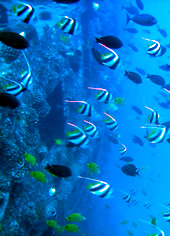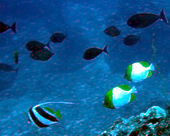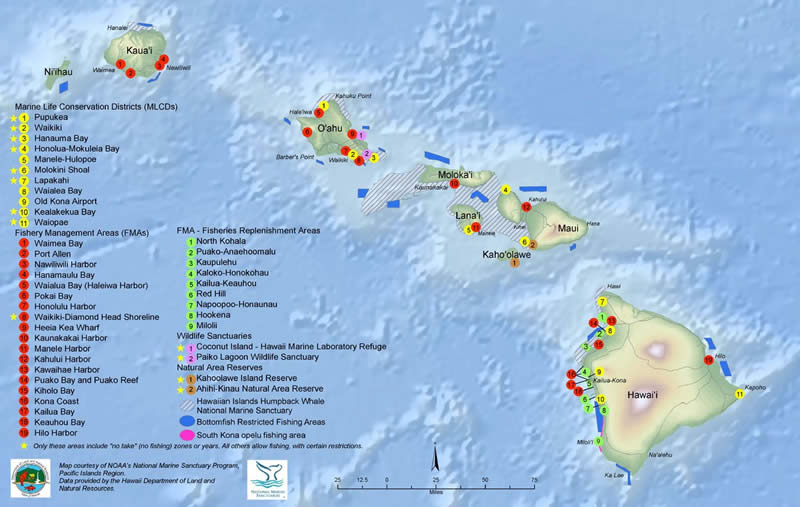Hawaii is Naturally Protected
Hawaii is geographically isolated in the middle of the Pacific Ocean with the United States 2400 miles away. Due to its isolation some fish species developed only in Hawaii’s waters. From Kure atoll to Hawaii the Big Island spans a distance of 1523 miles. Hawaii has one of the largest marine preserves in the World which spans 1100 miles (84 million acres) from Kure atoll to the Island of Kauai.
Of the Main Hawaiian Islands another 30 percent is protected by Sanctuaries, Marine Protected Areas, Fish Replenishment Areas (FRA), Marine Life Conservation Districts (MCLD), Refuges, Fishery Management Areas (FMA), National Monuments, restricted military areas and the strictest laws of any State in the Unite States.
Only Oahu, Maui and the Big Island Hawaii have any tropical fish collected from them. Hawaii has 28 million square feet of accessible ocean. The ocean covers most of this planet with fish outnumbering any other species on earth. The Main Hawaiian Islands have over 4,508 square miles of scuba accessible ocean.
Nearly 80 percent of dive accessible oceans around these three main Islands are untouched by tropical fish collectors. The vast majority of the Hawaiian Island shores are untouched by fishing and diving. High surf in the winter closes northern shores of all islands for many months. Summer surf affects southern shores. High winds from the east for most of the year shut down eastern shores for diving.
Poor accessibility too many areas due to distance, and lack of harbors and roads, ensure these areas will remain untouched. More than 90% of Hawaii is not impacted by fishing! Almost all of Hawaiian waters receive periods of “no catch” due to weather and inaccessibility. Mother Nature has already made sure that untouched areas are in place and will remain that way.
Small Collection Area
Tropical Fish Collection Areas Are Small
Tropical fish collecting is mainly limited to patches on the Kailua Kona coast (30% of which is protected by MPA) and West and South shores of Oahu. Maui has some collection but takes are small. Some patches of other areas are fished occasionally.
Scuba divers are mostly limited to depths of 30 to 120 feet. Only a few divers exceed these depths. Most of the Hawaiian Islands have steps of depths around them. Many fish inhabit the oceans from 10 feet to 600 feet deep. If a shallower depth ledge is depleted broadcast breeding form deeper depth replenishes many reef fish areas. Shallow areas are subject to surf so most diving is done deeper than 30 feet deep for these reasons.
Eighty five percent of the Big Island, almost all Maui, all Molokai, all Kahoolawe, all lanai, all Molokai, 50% Oahu, all Kauai, all Niihau and the northwest Hawaiian Islands are not fished by tropical fish divers.
2001 and 2002 Great annual fish counts conducted on several islands (www.reef.org) showed an increase of fish in areas counted by 2% to 23% for most species showing an overall increase in State’s fish populations. The DNLR $3 million MPA (Marine Protected Area) study showed an increase there as well (some species declined in counts there due to overpopulation-species crowding-ecosystems can only support a certain population).
University of Hawaii fish counts in Kaneohe Bay show fish increases and fish counts at all artificial reefs like the YO57 ship off Waikiki show increased fish counts. DNLR has done a great job placing artificial reefs around Oahu and needs to continue this practice.
Habitat increases fish counts! There is no scientific data showing population scarcity from tropical fish collecting. No fish in Hawaii has become extinct due to tropical fish collecting as far as we are aware!
Corals
Corals in Good Shape
Hawaii’s corals grow three to five inches per year, growth that is dependant on sunlight and depth. Only very near shore reefs in run off areas with little current are in decline; see (http://cramp.wcc.hawaii.edu/) study of Kaneohe and Maui.
Hawaii’s reef fish do not eat most of the seaweeds species which grow as a result of eutrophication and runoff. There is over 6 feet deep of new coral in many of Kaneohe Bay’s reefs that were dredged to 10 feet deep in the 1940’s.
One hundred million tons of coral have been dredged from Kaneohe after Pearl Harbor attack in preparation for world war two. Most Harbors in Hawaii are being dredged on a regular basis because coral growth is so quick.
CRAMP web site has one study of removing coral from a channel in Maui due to too much coral. Waikiki aquarium grows Acropera coral which grows at seven inches a year. Special permits are needed for Waikiki aquarium to sell coral.
Most of the Hawaiian Islands are untouched by tropical fish collecting. Corals in Hawaii are in great shape and are not impacted by tropical fish collecting.


